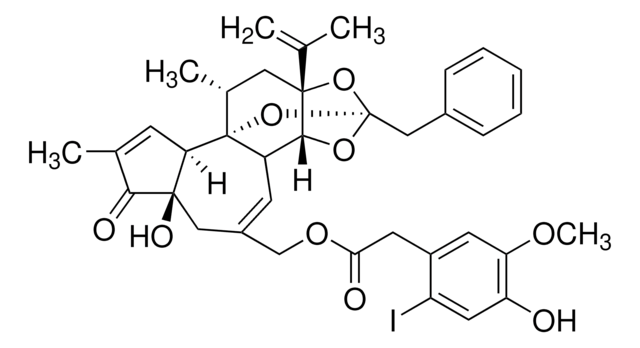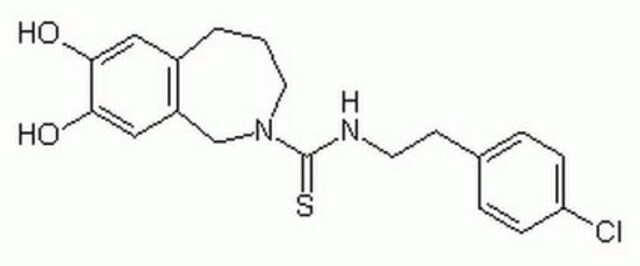Kluczowe dokumenty
R8756
Resiniferatoxin
from Euphorbia poisonii, ~95%
About This Item
Polecane produkty
pochodzenie biologiczne
Euphorbia poisonii
Poziom jakości
Próba
~95%
temp. przechowywania
−20°C
ciąg SMILES
[H][C@@]12C=C(C)C(=O)[C@@]1(O)CC(COC(=O)Cc3cc(O)cc(OC)c3)=CC4[C@H]5O[C@]7(Cc6ccccc6)O[C@]5(C[C@@H](C)[C@]24O7)C(C)=C
InChI
1S/C37H40O9/c1-21(2)35-17-23(4)37-29(33(35)44-36(45-35,46-37)19-24-9-7-6-8-10-24)14-26(18-34(41)30(37)11-22(3)32(34)40)20-43-31(39)15-25-12-27(38)16-28(13-25)42-5/h6-14,16,23,29-30,33,38,41H,1,15,17-20H2,2-5H3/t23-,29?,30-,33-,34-,35-,36-,37-/m1/s1
Klucz InChI
IKYCZSUNGFRBJS-PMIKMUNESA-N
informacje o genach
rat ... Trpv1(83810)
Zastosowanie
- for complex preparation for cryo-electron microscopy structural studies
- to test its effect towards immune responses to P. aeruginosa in sensory neurons associated with the cornea
- to study its effects in the denervation of the peripheral sensory nerves in psoriatic mice
Działania biochem./fizjol.
Hasło ostrzegawcze
Danger
Zwroty wskazujące rodzaj zagrożenia
Zwroty wskazujące środki ostrożności
Klasyfikacja zagrożeń
Acute Tox. 3 Oral - Skin Corr. 1A
Kod klasy składowania
6.1C - Combustible acute toxic Cat.3 / toxic compounds or compounds which causing chronic effects
Klasa zagrożenia wodnego (WGK)
WGK 3
Temperatura zapłonu (°F)
Not applicable
Temperatura zapłonu (°C)
Not applicable
Środki ochrony indywidualnej
Eyeshields, Faceshields, Gloves, type P3 (EN 143) respirator cartridges
Wybierz jedną z najnowszych wersji:
Masz już ten produkt?
Dokumenty związane z niedawno zakupionymi produktami zostały zamieszczone w Bibliotece dokumentów.
Klienci oglądali również te produkty
Nasz zespół naukowców ma doświadczenie we wszystkich obszarach badań, w tym w naukach przyrodniczych, materiałoznawstwie, syntezie chemicznej, chromatografii, analityce i wielu innych dziedzinach.
Skontaktuj się z zespołem ds. pomocy technicznej










